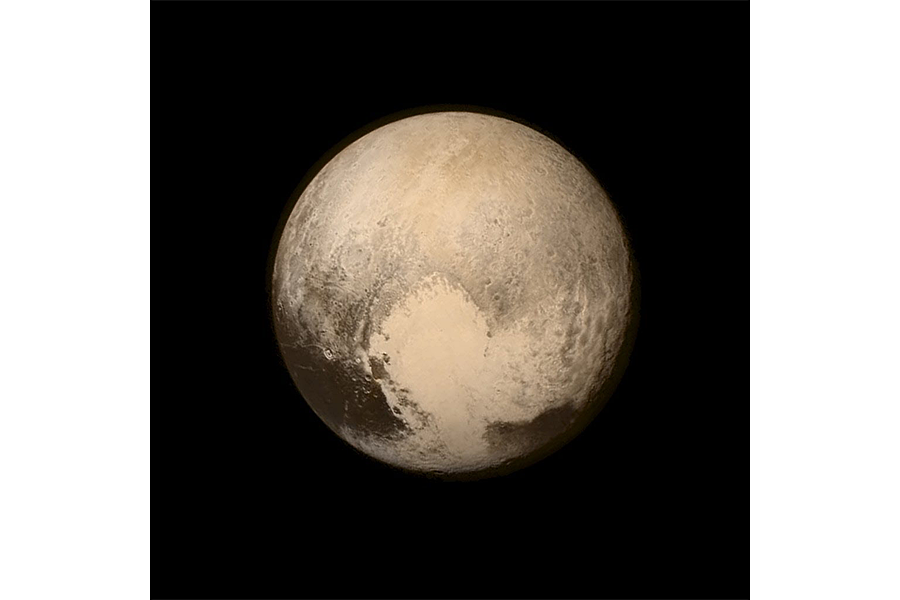Pluto's heart: How did it get so frosty?
The iconic dwarf planet at the edge of our solar system has an ice-filled heart that stands out from the rest, and now scientists have an idea why Pluto's it is so icy.
No, Pluto's heart didn't freeze when scientists demoted it to a dwarf planet in 2006. The model scientists propose in a new paper published in the journal Nature suggests a combination of the atmospheric pressure and geological features of Pluto yielded the bright, frozen contents of the heart-shaped region on the dwarf planet.
"It's a very simple story we tell," study co-author François Forget, a CNRS senior research scientist and astronomer at the Université Paris, tells The Christian Science Monitor in a phone interview. "It's not super fancy, but it explains a lot of what we see on Pluto," not just the bright Sputnik Planum basin within the so-called heart.
Dr. Forget and his PhD student, Tanguy Bertrand, designed a numerical thermal model to figure out what might be going on inside the intriguing heart and with the various exotic ices on Pluto.
In their model, they started by covering a model Pluto with a thin layer of all the ices known to be on the dwarf planet. When they ran a simulation of the dwarf planet's conditions over 50,000 years, they found that the ices became distributed as they were seen by New Horizons during the spacecraft's 2015 flyby of Pluto.
It turns out, the conditions under which nitrogen is ice are such that it forms even at the deepest parts of the Sputnik Planum basin, according to the model. And, because the atmospheric pressure there makes it particularly conducive to nitrogen ice, it forms a permanent nitrogen-ice reservoir, responsible for the brightness spotted by New Horizons.
"It's very clever, and shows a very interesting effect, that nitrogen ice wants to end up in the deepest regions on Pluto, which would be the Sputnik Planitia basin," William McKinnon, a planetary geologist who studies the outer solar system at Washington University in St. Louis but was not part of the study, tells the Monitor in an email.
Because of the conditions, carbon monoxide ice also is mixed in with the nitrogen in the basin. But methane ice, spotted frosting other parts of the basin and the dwarf planet, appears elsewhere because it is less volatile. The methane ice also seasonally covers both hemispheres of Pluto in the model, also aligned with New Horizons data.
This model could help explain some mysteries about Pluto's ices. Not only does the atmospheric pressure on Pluto explain why ice forms at the depths of the Sputnik Planum basin as opposed to on mountaintops like it does on Earth, but Forget also says he thinks he knows why there's so much ice close to Pluto's equator.
On Earth, the poles are the iciest because they are hit with the least direct sunlight and therefore are particularly cold. The same is true on Mars, says Forget, who has spent much of his career studying the Red Planet. "But on Pluto, it is different because the obliquity, the inclination of the axis of Pluto on its orbit, it's much higher than Mars or the Earth," he says. This means that the polar regions receive a lot more radiation from the sun during their summers, and the equator receives much less.
"They go beyond the previous analyses in that they apply a more complete numerical simulation of atmospheric dynamics and surface-atmosphere interactions than I've seen used before for Pluto," Josh Emery, a planetary scientist at the University of Tennessee, Knoxville who was not part of the study, tells the Monitor in an email. "They are careful to compare not only the resulting surface distributions of ices, but also the abundances of different gasses in the atmosphere, and the overall atmospheric pressure changes," he says of the model.
And, Dr. Emery adds, "By this virtue, they make two key predictions that can be used to test their model in the future: (1) the overall atmospheric pressure should decrease in over the next 10 years, and (2) the mid- and high-latitude frosts should be removed over a similar timescale."
Right now Forget and Mr. Bertrand's model fits all the data beamed back from the New Horizon's spacecraft, but future studies of Pluto and its atmosphere could help confirm or deny this theoretical model.
There is a lot of uncertainty in the model right now, Forget admits. But, according to his simulations, the methane ice that currently covers the northern hemisphere of Pluto should completely disappear within the next decade, proving, disproving, or refining the model. "So not too far in the future, we'll be able to see if Pluto does follow this evolution and it'll be a good test," he says. "If it does that, it will mean that we have a good story."








